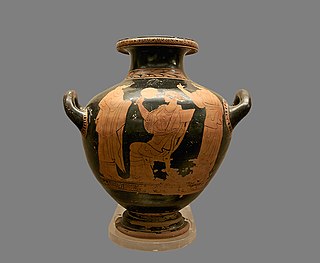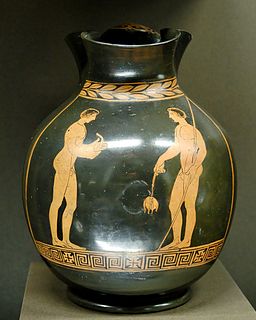
Black-figure pottery painting, also known as the black-figure style or black-figure ceramic is one of the styles of painting on antique Greek vases. It was especially common between the 7th and 5th centuries BC, although there are specimens dating as late as the 2nd century BC. Stylistically it can be distinguished from the preceding orientalizing period and the subsequent red-figure pottery style.

Exekias was an ancient Greek vase-painter and potter who was active in Athens between roughly 545 BC and 530 BC. Exekias worked mainly in the black-figure technique, which involved the painting of scenes using a clay slip that fired to black, with details created through incision. Exekias is regarded by art historians as an artistic visionary whose masterful use of incision and psychologically sensitive compositions mark him as one of the greatest of all Attic vase painters. The Andokides painter and the Lysippides Painter are thought to have been students of Exekias.

Red-figure vase painting is one of the most important styles of figural Greek vase painting.

The hydria is a form of Greek pottery that existed between the Late Geometric Period and the Hellenistic period. The etymology of the word hydria was first noted when it was stamped on a hydria itself, its direct translation meaning ‘jug’.

Lydos was an Attic vase painter in the black-figure style. Active between about 560 and 540 BC, he was the main representative of the '’’Lydos Group’’’. His signature, ό Λυδός, ho Lydos, the Lydian, inscribed on two vases, is informative regarding the cultural background of the artist. Either he immigrated to Athens from the Lydian empire of King Kroisos, or he was born in Athens as the son of Lydian parents. In any case, he learned his trade in Athens.
Geometric art is a phase of Greek art, characterized largely by geometric motifs in vase painting, that flourished towards the end of the Greek Dark Ages, c. 900–700 BC. Its center was in Athens, and from there the style spread among the trading cities of the Aegean. The Greek Dark Ages lasted from c. 1100 to 750 BC and include two periods, the Protogeometric period and the Geometric period, in reference to the characteristic pottery style. The vases had various uses or purposes within Greek society, including, but not limited to, funerary vases and symposium vases.

Polygnotos, a Greek vase-painter in Athens, is considered one of the most important vase painters of the red figure style of the high-classical period. He received his training in the workshop of the Niobid Painter and specialized in monumental vases, as in the manner of Polygnotos of Thasos, after whom he probably designated himself. He was the leading vase painter of the Group of Polygnotos which carries his name.

The pottery of ancient Greece has a long history and the form of Greek vase shapes has had a continuous evolution from Minoan pottery down to the Hellenistic era. As Gisela Richter puts it, the forms of these vases find their "happiest expression" in the 5th and 6th centuries BC, yet it has been possible to date vases thanks to the variation in a form’s shape over time, a fact particularly useful when dating unpainted or plain black-gloss ware.

Hermonax was a Greek vase painter working in the red-figure style. He painted between c. 470 and 440 BC in Athens. Ten vases signed with the phrase "Hermonax has painted it" survive, mainly stamnoi and lekythoi. He is generally a painter of large pots, though some cups survive.

The Pan Painter was an ancient Greek vase-painter of the Attic red-figure style, probably active c. 480 to 450 BCE. John Beazley attributed over 150 vases to his hand in 1912:
"Cunning composition; rapid motion; quick deft draughtsmanship; strong and peculiar stylisation; a deliberate archaism, retaining old forms, but refining, refreshing, and galvanizing them; nothing noble or majestic, but grace, humour, vivacity, originality, and dramatic force: these are the qualities which mark the Boston krater, and which characterize the anonymous artist who, for the sake of convenience, may be called the 'master of the Boston Pan-vase', or, more briefly, 'the Pan-master'."

The Analatos Painter was an Attic vase painter of the Early Proto-Attic style.

The Oreithyia Painter was an ancient Greek red-figure vase painter who flourished from 470–460 BCE. He is one of the many painters of the red-figure Classical Period, but his work is not considered the finest or well-known. This is partly because he began painting during the transition from red-figure to black-figure pottery.

The Altamura Painter was a classical Greek vase painter. He painted about 127 different vases during his career. Many of them were different types of pottery, such as amphorae, kraters, pelikei, and many others. The Altamura Painter's pottery work is dated from 475 BC to 425 BC. He mostly painted mythical gods and goddesses, as well as ordinary people.

The Pisticci Painter was a vase painter who lived in the second half of the 5th century BC. Many of his artistic works were discovered in Pisticci, a small town a few kilometers from Metaponto, Lucania, Italy.

The Leagros Group was a group of Attic black-figure vase painters active during the last two decades of the 6th century BC. The name given to the group by modern scholars is a conventional one, derived from a series of name vases.

A Caeretan hydria is a type of ancient Greek painted vase, belonging to the black-figure style.

The Underworld Painter was an ancient Greek Apulian vase painter whose works date to the second half of the 4th century BC.

Python was a Greek vase painter in the city of Poseidonia in Campania, Southern Italy, one of the major cities of Magna Graecia in the fourth Century BC. Together with his close collaborator and likely master Asteas, Python is one of only two vase painters from Southern Italy whose names have survived on extant works. It has even been suggested that the joint workshop of Asteas and Python in Paestum was a family business.

Ancient Greek funerary vases are decorative grave markers made in ancient Greece that were designed to resemble liquid-holding vessels. These decorated vases were placed on grave sites as a mark of elite status. There are many types of funerary vases, such as amphorae, kraters, oinochoe, and kylix cups, among others. One famous example is the Dipylon amphora. Every-day vases were often not painted, but wealthy Greeks could afford luxuriously painted ones. Funerary vases on male graves might have themes of military prowess, or athletics. However, allusions to death in Greek tragedies was a popular motif. Famous centers of vase styles include Corinth, Lakonia, Ionia, South Italy, and Athens.

The Athenian Band Cup is an Attic Greek kylix, attributed to the Oakeshott Painter. It is further classified as a band cup, a type of Little-Master cup.




















